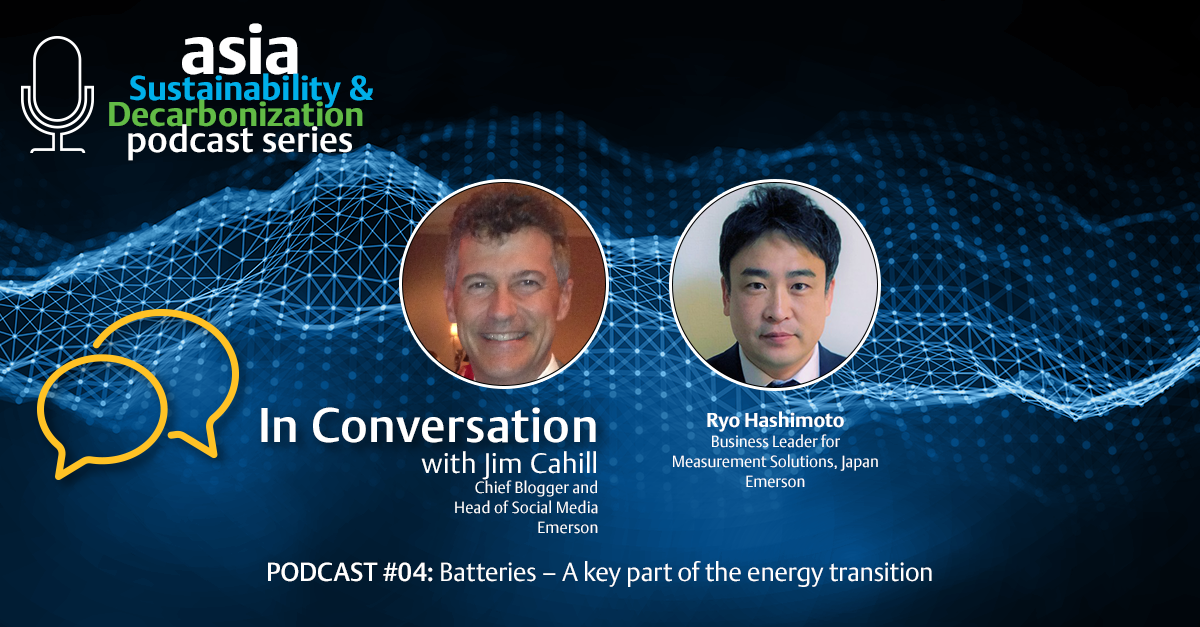Podcast: Play in new window | Download (Duration: 18:06 — 16.6MB) | Embed
 Moving from combustion-based energy to renewable energy is one of several decarbonization strategies. An example is a move from internal combustion engine vehicles to battery and fuel cell-powered vehicles.
Moving from combustion-based energy to renewable energy is one of several decarbonization strategies. An example is a move from internal combustion engine vehicles to battery and fuel cell-powered vehicles.
In this episode in our continuing Asia-Pacific Sustainability & Decarbonization podcast series, Emerson’s Ryo Hashimoto joined me to discuss the electrification trend and battery developments as an energy storage solution.
Visit the Sustainability & Decarbonization section on Emerson.com or connect with a local expert in your country in the Asia-Pacific region.
Conversation Notes
Jim: Hi everyone. This is Jim Cahill with another “Emerson Automation Experts” podcast. We continue our Asia-Pacific Sustainability & Decarbonization podcast series with a closer look at Electrification especially for batteries as an energy storage solution and its growing importance for the Net Zero Emission goal in this region. I am joined today by Emerson’s Ryo Hashimoto to discuss Electrification. Welcome, Ryo!
Ryo: Hi Jim. Thanks for having me on the podcast.
Jim: Ryo it’s great to have you here with us. Let’s begin by asking you to share your background and path to your current role with our listeners.
Ryo: Thanks Jim. Well, I joined Emerson in Japan in 2004 and having several roles such as strategic planner, Marketing, and Business development.
- In 2011, I moved to Singapore as a Product manager for Analytical Instruments in Emerson Automation Solutions Asia Pacific.
- The role was serving something related to the Sustainability and Decarbonatization
- The main purpose of analyzing water quality is for Health, Safety and Environment.
- During that time, I published several articles related to water analysis and some of them were picked up by you, Jim, in your blog post. So, I am really glad to be back in your session again.
- Then I am back to Japan and on top of my main responsibility, I extended my responsibility to support Sustainability and Decarbonization initiative in Emerson Automation Solutions Japan
- and furthermore, I am taking a role of supporting Electrification business mainly for Battery under Emerson’ Sustainability and Decarbonization business in Asia Pacific.
Jim: Thanks for sharing your background, Ryo! What are some ways battery usage has advanced?
Ryo:
- As you know, Battery itself, especially for Lithium-ion (Li-ion) batteries are nothing new to us that the technology itself was developed during 1980’s and the first commercialization was done by Sony in 1991.
- Since then, these batteries have applied in consumer electronics, computers and others devices and have brought lots of benefits.
- For example, Mobile devices powered by battery such as smartphones, tablets and laptops allow us to work from anywhere and make us reachable to the data and information literary from anytime anywhere in the world. So probably I can say that the battery is essential and critical product to sustain our business and private life
- And now under current carbon neutralization and Net Zero movement, the importance of the battery is increasing mainly driven by two major Energy segments.
Jim: In sustainability and decarbonization, the demand for batteries is discussed a lot these days. Can you elaborate what are the main drivers for battery usage in the energy mix?
Ryo: As I mentioned, there are two major sources that driving the battery demand.
- One is renewable energy such as Wind and Solar power that require energy storage for stable power supply and
- another is road transportation sector that is moving from internal Combustion Engine to Electric vehicles for all segment from Light duty to mid to heavy duty vehicles.
- According to report published by US Department of Energy in 2020, the battery demand share from EV will be around 90% in 2030 while from stationary storage application and consumer electronics will be 10%.
- The capacity demand itself varies based on different scenarios such as Net Zero, Stated Policies and so on but it really indicates that the EV will be the main driver for Energy storage capacity demands for future.
Jim: So what is actually required for battery capacity in 2030 and what is the current deployed capacity? And, how much is needed to ramp up battery production capacity?
Ryo:
- IEA reported the battery capacity demand projection based on different scenario. I picked up two here
- 1st scenario is Stated policy scenario, which is based on 7 major countries stated policy, the battery demand will be 1,600GWh in 2030. The capacity in 2020 is estimated 300GWh per annum and actual production was 160GWh so the demand is expected grow exponentially.
- 2nd scenario is Sustainable development scenario that is assuming 30% of car sales is xEV, then the expected demand will be 3,200GWh in 2030 and this will be 10 times of the capacity in 2020.
Jim: Wow, that’s quite an increase required! Can the battery industry meet the demand for the 2nd scenario? If not, what can be done?
Ryo:
- This is why we are seeing lots of announcement and news about investments from battery manufacturers
- According to IEA and Bloomberg New Energy Finance report, when the planned manufacturing capacities published in the market are added together, the expected production capacity will be more than 3,000GWh in 2030
- So luckily the market demand would be able to be fulfilled if all manufacturers are executed their capacity expansion as they planned.
Jim: What are some technical trends in the Battery market?
Ryo: As I mentioned at the beginning, Lithium Ion Batteries are there for more than decades but the technology is continuously improving. Currently what we are seeing is 3 major trends.
- First of all, when we look at EVs, Nickel, Cobalt, Manganese, so-called NCM is the major components for cathode of the battery.
- The reason why NCM is popular in EVs is that it provides high energy density and stable charging and discharging characteristics.
- When we look more on NCM, depending on the share of materials, it is called NCM811, 622 and so on. NCM 811 means 80% of Nickel, 10% of Cobalt and Manganese respectively.
- The reason for higher Nickel share is that Nickel is important to provide energy density for the battery that will affect the total capacity of the battery.
- Another reason for NCM811 is getting popular now is that it can reduce the use of cobalt, which is rare metal and have limited supply.
- Secondly, LFP, Lithium-Ion Phosphate technology.
- The LFP has not been popular due to its lower energy density and charging speed but Cell-To-Pack technology developed in China overcome those points and getting the market momentum now. The benefits of LFP is cheaper and not using cobalt at all in cathode material.
- Lastly but not least is All Solid-state Battery and Sodium ion Battery
- Both of batteries is still in development or pilot phase and is needed to establish mass production technologies and methods to be in the market
- The benefits of All solid-state battery is huge that higher energy density, lighter weight, less charging time, safe and list is going on.
- I wish we can have these technologies ready now but it is estimated to be commercialized sometime late 2020’s or even later.
Jim: What are some challenges in the Battery market?
Ryo: There are several challenges in the market, but I like to pick up one of them.
- It is about minerals for energy storage solutions.
- I mentioned previously that the battery demand will be rapidly expanding to 1,600GWh till 2030. In order to produce that capacity, the demand for Lithium will see 8x increase, a 19x increase in nickel, 4x increase in cobalt and a 7x increase for Graphite. The graphite is a main component for Anode electrode.
- All of those minerals are mainly extracted in 3 to 4 countries. For Lithium, Australia, China and Chile and 3 countries account for 85% of global supply.
- For Cobalt, RDC is around 60%
- Nickel is from Indonesia, Philippines and these two account for 6-70% of total supply.
- What I like to highlight here is that unlike oil and gas, the source of the minerals are very limited and Asia plays key roles to supply those key minerals in battery market
- As Emerson, we are supporting our mining and refining customers in Australia and China, helping their automation in the process to improve safety and efficiency of the operation
- For instance, we are serving as MAC for several mining & refining projects in these areas.
Jim: Demand for metal components in Lithium Ion Batteries is one of the challenges. How about battery price? For road transportation electrification, the cost is inevitably a concern area.
Ryo:
- According to BloombergNEF, battery pack $value per KWh has been going down since 2010.
- Battery pack price per KWh was $1,200 in 2010 and now down to $132 in 2021, which is around 89% price reduction
- The cost per KWh will follow the same trend and expected to reach below $100 in 2024.
- However, due to supply chain issues, demand surge leading by China and other geopolitical concerns raised a price for minerals. E.g. Lithium price grew by more than10% in 2022.
Jim: What are some ways these challenges can be addressed?
Ryo: There are several points to mention here but the interest of time I just want to mention 1 or 2 here.
- Firstly, technology development may help us to reduce the use of those minerals, provide alternatives or use nothing for those minerals.
- g. LFP Lithium Ion Phosphate is the one that not using those minerals.
- as I mentioned new technologies such as All-Solid-State and other types of cathode will help to mitigate those risk
- Another area we can think of is about recycling. Recycling of battery minerals/metals are getting hot now in Asia
- Unlike fossil fuel, those metals and minerals will not lose chemical properties after use to various degree so it can be recycled.
- Well, I want to deep dive for this topic but this is our next Electrification topic for podcast so let’s discuss this in details in the next Electrification podcast.
Jim: And finally, where can our listeners go to learn more?
Ryo: Visit our sustainability & decarbonization webpage to learn more solutions for batteries and other decarbonization technologies. Also, see the contact details of the Emerson Sustainability & Decarbonization expert for your respective countries here in Asia Pacific.





